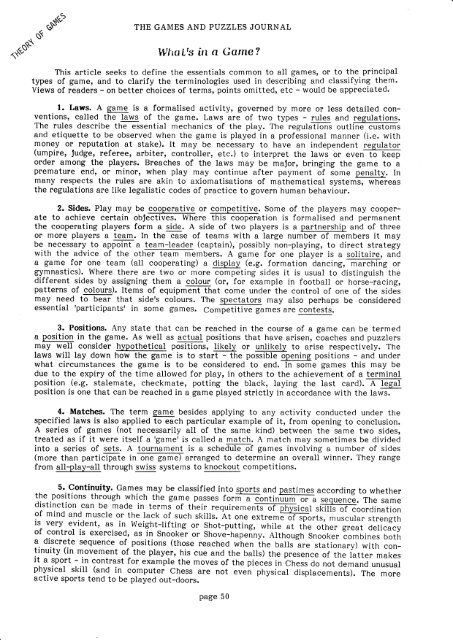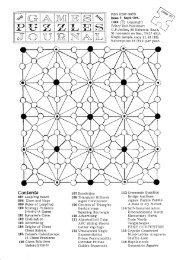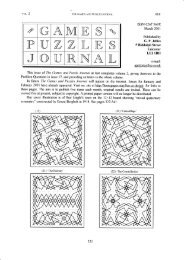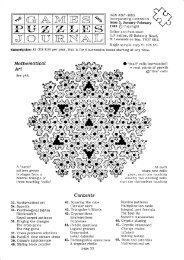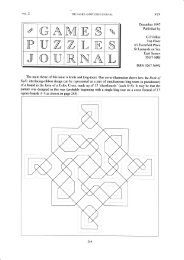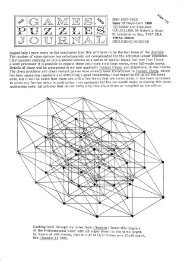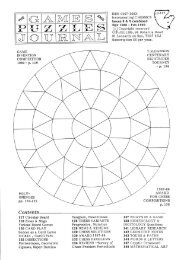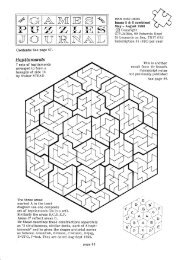The Games and Puzzles Journal, #4 - Mayhematics
The Games and Puzzles Journal, #4 - Mayhematics
The Games and Puzzles Journal, #4 - Mayhematics
You also want an ePaper? Increase the reach of your titles
YUMPU automatically turns print PDFs into web optimized ePapers that Google loves.
. s"s<br />
.u$<br />
THE GAMES AND PUZZLES JOURNAL<br />
lt/fratrit irt o Ganrc<br />
This article seeks to define the essentials common to all games, or to the principal<br />
types of game, <strong>and</strong> to clarify the terminologies used in describing <strong>and</strong> classifying them.<br />
Views of readers - on better choices of terms, points omitted, etc - would be appreciated.<br />
1. Laws. A game is a formalised activity, governed by more or less detailed conventions,<br />
called the laws of the game. Laws are of two types - rules <strong>and</strong> regulations.<br />
<strong>The</strong> rules describe the essential mechanics of the play. lhe regulations outtiiilGTffis<br />
<strong>and</strong> etiquette to be observed when the game is played in a professional manner (i.e. with<br />
money or reputation at stake). It may be necessary to have an independent regulator<br />
(umpire, ludge, referee, arbiter, controller, etc.) to interpret the lawJ or evenffip<br />
order among the players. Breaches of the laws may be maJor, bringing the game to a<br />
premature end, or minor, when play may continue after payment of some penalty. In<br />
many respects the rules are akin to axiomatisations of mathematical systems, whereas<br />
the regulations are like legalistic codes of practice to govern human behaviour.<br />
2. Sides. Play may be cooperative or eompetitive. Some of the players may cooperate<br />
to achieve certain obJectives. Where this cooperation is formalised <strong>and</strong> permanent<br />
the cooperating players form a side. A side of two players is a partnership <strong>and</strong> of three<br />
or more players a team. In the case of teams with a large number of members it may<br />
be necessary to appolit a team-leader (captain), possibly non-playing, to direct strategy<br />
with the advice of the otnEF-IE6ffi-embers. A game for one piayer is a solitaire, <strong>and</strong><br />
a game for one team (all cooperating) a display (e.g. formation dancing,-maichlng or<br />
gymnastics). Where there are two or more competing sides it is usual to distinguish the<br />
different sides by assigning them a colour (or, for example in football or horsb-racing,<br />
patterns of colours). Items of equipment that come under the control of one of the sides<br />
may need to bear that side's colours. <strong>The</strong> spectators may also perhaps be considered<br />
essential 'participantst in some games. Competitive games are conteqts.<br />
3. Positions. Any state that can be reached in the course of a game can be termed<br />
a position in the game. As well as actual positions that have arisen, coaches <strong>and</strong> puzzlers<br />
may well consider hypothetical positions, likely or unlikely to arise respectively. <strong>The</strong><br />
laws will lay down how the game is to start - the possible opening positions - <strong>and</strong> under<br />
what circumstances the game is to be considered to end. In some games this may be<br />
due to the expiry of the time allowed for play, in others to the achievement of a terminal<br />
position (e.g. stalemate, checkmate, potting the black, laying the last card). ...l@<br />
position is one that can be reached in a game played strictly in accordance with the lawi.<br />
4. Matches. <strong>The</strong> term game besides applying to any activity conducted under the<br />
specified laws is also applied to each particular example of it, from opening to conclusion.<br />
A series of games (not necessarily all of the same kind) between the same two sides,<br />
treated as if it were itself a 'game' is called a match. A match may sometimes be divided<br />
into a series of sets. A tournament is a schedTiEl6-f games involving a number of sides<br />
(more than partiii[-ate inrc arranged to determine an overall winner. <strong>The</strong>y range<br />
from all-play-all through swiss systems to knockout competitions.<br />
5. Continuity. <strong>Games</strong> may be classified injo gpLlQ <strong>and</strong> pastimes according to whether<br />
the positions through which the game passes form-T continuum or a sequence. <strong>The</strong> same<br />
distinctioncanbemadeintermJoftheirrequirements;rEfutr'ffid;i#i;;<br />
of mind <strong>and</strong> muscle or the lack of such skills. At one extreme of sports, muscular strength<br />
is very evident, aq in Weight-lifting or Shot-putting, while at tire otn"r. great delicacy<br />
of control is exercised, as in Snooker or Shove'-hup"ilny. Although Snooker combines both<br />
a. discrete sequence of positions (those reached when the balls lre stationary) with eontinuity<br />
(in movement of- the player, his cue <strong>and</strong> the balls) tne presen"" of the latter makes<br />
it a sport - in contrast for example the moves of the pieces in Chess do not dem<strong>and</strong> unusual<br />
physical skill (<strong>and</strong> in computer Chess are not even physical displacements). <strong>The</strong> more<br />
active sports tend to be played out-doors.<br />
page 50


